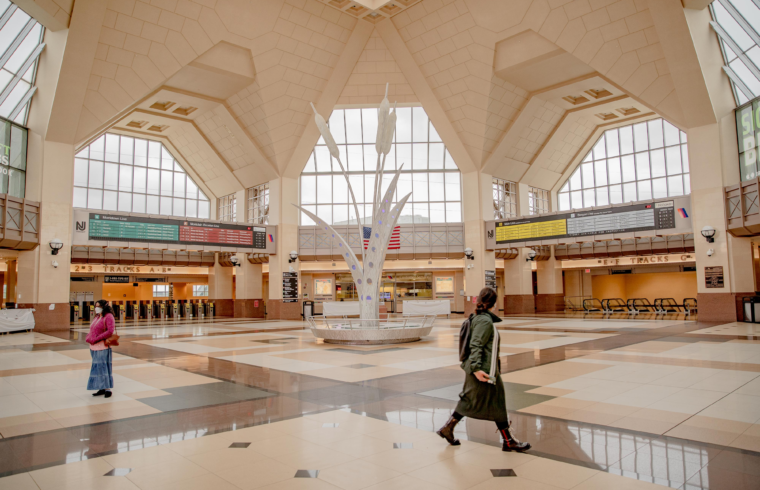While President Joe Biden pushes for $2.3 trillion in infrastructure spending with billions for mass transit, operators of commuter rail and buses are fretting over a burgeoning work-from-home culture that threatens to depress revenue for years after the pandemic.
Before the white-collar American workday became a homebound litany of video meetings with a backbeat of tumble-drying laundry, almost 12% of workers in the largest metropolitan areas were mass-transit commuters, according to the U.S. Census. Just 45% of ridership is back nationally, according to the American Public Transportation Association, even as the U.S. averages 2.2 million Covid-19 shots per day and major cities are reopening.
Public transportation depends on the ability to crowd trains and buses with enough passengers to cover costs. For now, $30.5 billion in federal aid is helping operators such as New Jersey Transit to keep fares steady and Washington’s Metro to avoid service cuts. Without that money, and without more riders, the future of mass transportation looks bleak.
The crisis could stop a decades-long effort to reclaim cities from car-enabled sprawl, creating denser, walkable cores with businesses and housing alike. And even if companies insist that their employees return to the office full time, they may be hard put to get there.
“Transit use will have to increase,” said Tom Wright, president and chief executive officer of the Regional Plan Association, an independent New York City-area research group. “They’re going to need to pay for their operations as they did before.”

Secaucus Junction Station, a hub for New Jersey Transit, sits empty in the early morning on Monday May 10, 2021.
Photographer: Amir Hamja/Bloomberg
For companies seeking to bring workers back to the office, the commute presents an issue in luring employees who rely on public
transportation but are wary of Covid, service cuts and crime. The two metropolitan areas with the lowest share of people back in the office are San Francisco and New York, dense population centers with heavily used mass transit, according to security company Kastle Systems. The returns are greater in more driving-centric cities.
If more commuters take up driving, the effects could be profound. A Vanderbilt University study last year predicted disastrous traffic should just 25% of mass-transit and car-pool commuters switch to single-occupancy cars. The cities most at risk were San Francisco, New York, Los Angeles, Boston and Chicago.“ Cities that depend on transit are at risk for extreme traffic unless transit systems can resume safe, high-throughput operations quickly,” the study concluded.
In Chicago, only 80% of onetime daily subway, train and bus passengers anticipate returning. San Francisco’s Bay Area Rapid Transit rail system doesn’t expect ridership to hit pre-pandemic levels until 2024, and sees no growth until later in the decade.
While JPMorgan Chase & Co. and other Wall Street banks have told employees to return to their desks in the coming weeks, other employers are pushing the nation’s most consequential office-culture shift since Congress enacted the 40-hour workweek in 1940.
The trend is nationwide. Salesforce.com Inc., San Francisco’s largest private employer, is offering flexible work to most of its employees. New York’s Verizon Communications Inc. is testing home-based, hybrid and office arrangements, citing a Morning Consult survey that found that just 25% of 3,000 respondents want to be at their offices a year from now.
See also: How ‘Work From Home’ Became ‘Work From Anywhere’
“You get a lot of hours back in your day, and that helps with work-life balance,” Jarrett Lilien, president and chief operating officer of Manhattan-based WisdomTree Investments, said in an interview. The company adopted a “remote-first” policy for its 227 workers globally.
In a survey released in March, employers of 174 major companies told the Partnership for New York City, a nonprofit group, that they expect more than half of office employees to work remotely at least part time. The city taps the suburbs for about one-fifth of its office workers, who endure some of the nation’s longest commutes, averaging 32 minutes one way, according to the Census.

Port authority bus terminal in Manhattan on Monday, May 10, 2021.
Photographer: Amir Hamja/Bloomberg
Biden, nicknamed “Amtrak Joe” for his decades of commuting and advocating for the passenger railroad, is proposing the nation’s biggest-ever infrastructure and jobs-creation effort, with $2.3 trillion for transportation, housing, schools, utilities and other purposes. Republican Mitch McConnell, the Senate minority leader, says $800 billion would be more acceptable.
“I think of it as the next three to six months when we’re really desperate to get people to come back to New York, come back to the New York economy, come back to the transit system,” Sarah Feinberg, New York City Transit’s interim president, told WABC Radio on Sunday. The subway plans to resume 24-hour service on May 17, two days before the city intends to fully reopen.
The subway carried 2.4 million people on Friday, the highest since the coronavirus outbreak began, but that’s just 40% of the pre-pandemic weekday average. The MTA’s Metro North suburban rail has about 30% of its typical ridership, while the Long Island Rail Road has 32%. Even if system-wide ridership increases to 86% of pre-pandemic levels, it still could mean a projected $900 million deficit atop existing structural budget gaps, according to Pat Foye, the MTA’s chief executive officer.
“The receipt of federal fiscal stimulus alleviates pressure on the MTA’s credit profile, but the agency still faces considerable challenges to align a fairly inflexible expenditure base against revenues that it estimates will remain below 2019 levels through 2024,” Fitch Ratings wrote in a March 17 note.
At NJ Transit, too, rail ridership remains at 25% to 30% of pre-Covid levels as fewer people commute into Manhattan. Recovery will be slow, Governor Phil Murphy said on May 4.
NJ Transit’s Year of Pain
The nation’s largest statewide mass-transportation agency, with trains, buses and light rail, had a 90% ridership drop during the pandemic’s peak
Source: NJ Transit annual reports for fiscal years ending June 30

While the MTA will receive a combined $14.5 billion of federal aid to cover lost revenue, it’s looking to add riders to help stave off future shortfalls. On Monday, New York Governor Andrew Cuomo said some stations will start offering single-shot Covid-19 vaccinations with free MetroCards or rail tickets as incentives.
Even simple steps can boost passenger confidence, according to Veronica Siranosian, a vice president for Aecom Ventures, whose technology-driven transportation projects can rely on passenger surveys.
“In some cases when we ask, ‘What would be a satisfactory level of cleanliness for you?’ people say, ‘I want it to smell like bleach,’” Siranosian said in an interview. “They really do want these kind of visible and sensory confirmations that the station areas have been cleaned.”
Still, one-third of former New York City subway regulars say they’re not riding because of escalating violence, according to a Metropolitan Transportation Authority poll from March 15-28. In the past week alone, an off-duty conductor was slashed, a tourist stabbed with a screwdriver and a third rider sliced with a razor.
“A guy walked onto my subway car without a mask and I muttered something under my breath and he got belligerent with me,” Jason Tebbe, a 45-year-old history teacher who
commutes to Manhattan from Maplewood, New Jersey, said in an interview. “I shouldn’t have said anything. I don’t know what someone’s going to do.”
Across the country, the Los Angeles County Metropolitan Transportation Authority’s bus and rail, which had an average weekday daily ridership of 1.2 million in March 2019, had just 569,000 passengers in March 2021.
It’s in the midst of a construction boom, thanks to voter-approved tax increases intended to fund new subway lines and other improvements, but that revenue is down because of the pandemic. Bus fares vanished, too, as riders were kept socially distant from drivers by entering from the back of the bus. Still, Metro officials are pushing ahead on free fares for students — a proposal made before the pandemic — and angling for more Biden administration aid to subsidize.
In San Francisco, the Bay Area Rapid Transit system by June 2022 expects to regain just 70% of pre-pandemic ridership. In the Embarcadero financial district on May 7, the waterfront throbbed with street musicians and scooters; underground, the subway platform was silent at times.
Still, the system’s administration has some confidence: Ridership topped itself each day during the week of May 2, for the most since the pandemic began, according to Alicia Trost, a BART spokeswoman.
Among those who have come back was Andalusia Masad, a speech language pathologist at the Tenderloin Community Elementary School in San Francisco.
“I restarted taking public transit once schools reopened, just because I prefer it to driving,” Masad said in an interview at the Embarcadero stop. “I think it’s an interesting way to be connected with the community.”
— With assistance by Christopher Palmeri, Sarah Holder, and Henry Goldman
(Updates with new NJ Transit ridership figures)











